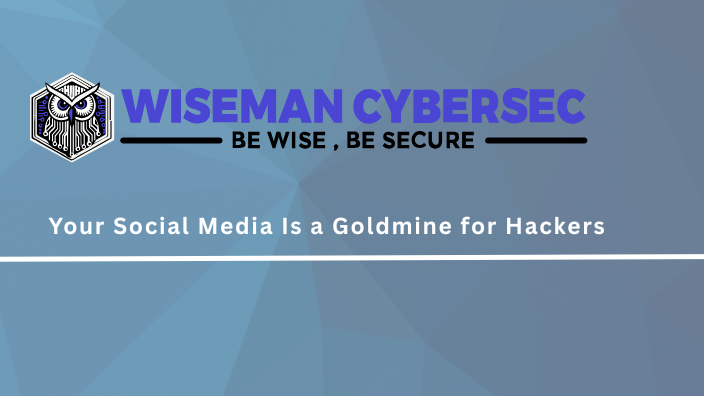
We use social media to connect, share, and stay updated. It’s where we celebrate birthdays, post about new jobs, share vacation photos, and sometimes even vent about work. But while you’re scrolling, liking, and posting, someone else might be watching—with very different intentions.
For hackers and social engineers, social media is one of the most effective and underrated tools for gathering information. You may not realise it, but your public profile often gives attackers everything they need to craft a convincing scam, steal your identity, or infiltrate your organisation.
Let’s break down exactly how that happens—and what you can do about it.
1. Personal Details Become Clues for Attacks
That Instagram caption about your childhood dog? The Facebook memory from your first school? The tweet about your favourite band growing up? These may seem harmless, but they’re often the exact answers to common security questions used for password recovery.
Even worse, this information is often publicly available to anyone with a browser.
Examples hackers look for:
- Pet names, birthdays, and school names
- Hometown and current city
- Mother’s maiden name
- Favourite hobbies, sports teams, or childhood memories
- Names of children or relatives
Once they collect enough of this information, attackers can start building a profile of you, which they may use for identity theft, social engineering, or password guessing attacks.
2. LinkedIn Is a Treasure Trove for Corporate Reconnaissance
LinkedIn is valuable for networking, but it’s also a favourite of cybercriminals conducting reconnaissance before targeting an organisation.
Here’s what hackers can easily find:
- Your current role and responsibilities
- The technology stack your company uses (often visible in endorsements or posts)
- Reporting structure, giving away internal hierarchy
- New hires and recent promotions, indicating possible gaps in training or security
Armed with this information, an attacker can create a highly targeted phishing email—one that appears legitimate because it uses real details from your role or team. That’s what makes spear phishing so dangerous: it looks authentic because it’s built on truth.
3. Oversharing Gives Away Timing and Access
You might be surprised at how often people post:
- “Excited to be on vacation for the next two weeks!”
- “Finally heading out for a client visit—back late tonight.”
- “Working late on a new product launch.”
While those posts seem innocent, to a hacker, they signal:
- When you’re unavailable (and less likely to notice suspicious activity)
- What projects you working on (which systems might be involved)
- What tools or platforms you using (attack surface info)
This is known as timing-based social engineering, and yes, attackers absolutely take advantage of it.
4. Fake Profiles and Impersonation Are Easier Than You Think
If you’re posting photos, work info, and contact details, a hacker doesn’t need much more to create a fake version of you. Impersonation attacks often involve:
- Cloning your social media profile
- Connecting with your coworkers or clients
- Sending them fake messages asking for urgent help, account access, or payment
This is often used in business email compromise (BEC) scams, where attackers pretend to be an executive or colleague to get financial information or credentials.
And since people tend to trust familiar names and faces online, it works.
5. One Weak Link Is All It Takes
Even if you’re cautious, someone in your circle may not be. Hackers often target the least tech-savvy person in your network, using their access to pivot toward you.
This is how indirect social engineering works:
- Attacker connects with a friend or coworker
- Gains trust, then requests access to shared resources or sends malicious links
- Uses that compromised access to go after a higher-value target—you
Social media gives attackers a map of your digital relationships—and they know how to exploit them.
What You Can Do to Protect Yourself
You don’t need to stop using social media. You just need to start treating it like part of your digital identity, because it is.
Here are steps you can take right now:
1. Tighten Privacy Settings
- Set your posts to “Friends Only” or “Connections Only”
- Limit who can see your friends list or contact info
- Review what others can post or tag you in
2. Be Mindful of What You Share
- Avoid posting sensitive work details, travel schedules, or personal identifiers
- Think before you post about things commonly used for security questions
3. Watch for Fake Profiles
- Be sceptical of duplicate accounts or connection requests from people you’re already connected to
- Always verify suspicious messages, especially if they seem urgent
4. Use Strong Passwords and MFA
- Never reuse passwords across social and work accounts
- Enable multi-factor authentication (MFA) on all platforms
5. Educate Your Network
- Share awareness with friends and coworkers
- Encourage them to secure their profiles too—your security can depend on theirs
Final Thoughts
Hackers no longer have to break into systems—they can often just browse your social media and find what they need. From identity theft to corporate breaches, the trail often starts with a simple post, a photo, or a bio update.
Social media can be fun and useful—but in the wrong hands, it’s also dangerous.
Stay aware. Post with purpose. And always remember: what you share online can shape how secure you really are offline.
Very informative, thank you for sharing. I loved it.